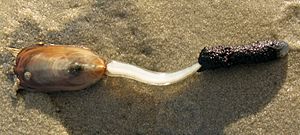Lingula facts for kids
Quick facts for kids LingulaTemporal range: Ordovician (488 mya) – Recent
|
|
|---|---|
 |
|
| Lingula anatina from Stradbroke Island, Australia. | |
| Scientific classification | |
| Kingdom: | |
| Phylum: | |
| Class: | |
| Family: |
Lingulidae
|
| Genus: |
Lingula
|
Lingula is a type of sea animal called a brachiopod. It belongs to the class Lingulata. Lingula has been around for a very long time, since the early Ordovician period. That's about 488 million years ago! Because it has changed so little over millions of years, Lingula is a great example of a living fossil. Like all brachiopods, it gets its food by filtering tiny bits from the water.
Contents
What is a Brachiopod?
Brachiopods might look a bit like clams or oysters. This is because they both have two shells. However, brachiopods are different from clams in important ways. Clams have shells that are mirror images of each other, one on the left and one on the right.
How Lingula is Different
Lingula and most other brachiopods have shells that are on the top (dorsal) and bottom (ventral). These shells are not mirror images. Also, Lingula has a special stalk, called a peduncle. This stalk sticks out from a hole near the tip of one of its shells. It uses this stalk to anchor itself to the sand or mud on the seafloor. Clams, on the other hand, might attach to things using thin threads called byssus filaments. These threads come out from between their shells.
A True Living Fossil
The Lingulata brachiopods, which Lingula belongs to, have lived on Earth for over 500 million years! They first appeared during the Cambrian period. Modern Lingula species look very much like their ancient fossil ancestors. This amazing survival makes them a perfect example of a "living fossil." It means they have hardly changed over vast periods of time.
Images for kids
See also
- Living fossil
- Brachiopod
- In Spanish: Língula para niños



